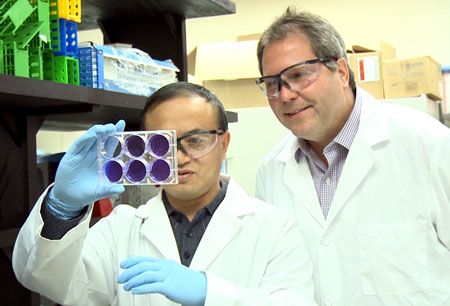K-State veterinary researchers create new method of avian influenza vaccine development
Testing shows method may extend beyond poultry to pigs, cattle and sheep.

Wenjun Ma, assistant professor of diagnostic medicine and pathobiology at Kansas State University, left, and Jürgen Richt, Regents distinguished professor of veterinary medicine and director of the U.S. Department of Homeland Security's Center of Excellence for Emerging and Zoonotic Animal Diseases, have developed vaccines for H5N1 and H7N9, two emerging strains of avian influenza currently circulating in Asia. The strains are zoonotic and can be transmitted from chickens to pigs and humans. While the avian influenza strain H5N2 has caused the culling of more than 40 million chicken, turkeys and pheasants in the U.S., veterinary researcher Jürgen Richt, DVM, PhD, and his colleagues have developed a vaccine for two strains of zoonotic-and often deadly-avian influenza viruses circulating in Asia. Testing shows this new method of development may expedite vaccine development for other emerging strains of avian influenza.
Although H5N1 and H7N9 influenza viruses are not circulating in commercial flocks in America-H5N1 has been documented in domestic wild birds and Canada has reported two cases of H7N9-the strains have meant the loss of millions of commercial chickens and turkeys and the deaths of hundreds of people in Asia. The case fatality rate for humans infected with H5N1 is approximately 60 percent.
The vaccines developed by Richt, Regents distinguished professor of veterinary medicine at Kansas State University's College of Veterinary Medicine and director of the U.S. Department of Homeland Security's Center of Excellence for Emerging and Zoonotic Animal Diseases, protect against H5N1 and H7N9. Plus, the method used for their development is expected to help researchers develop vaccines for other strains. "This could reduce the number and intensity of large-scale outbreaks at poultry farms as well as curb human transmission," a K-State release states.
Richt and his colleagues developed the H5N1 vaccine by combining two viruses. A recombinant virus was created from a clone of a Newcastle disease vaccine strain into which a small section of the H5N1 virus was transplanted. Tests showed that the new recombinant virus vaccinated chickens against both Newcastle disease virus and H5N1, according to K-State.
Richt then set his sights on H7N9, which kills about one in three people infected, and achieved the same result. "We believe this Newcastle disease virus concept works very well for poultry because you kill two birds with one stone, metaphorically speaking," Richt says. "You use only one vector to vaccinate and protect against a selected virus strain of avian influenza." Work has already begun on a H5N2 specific vaccine, which could be done within six to eight weeks. Iowa-based Harrisvaccines also has a H5N2 vaccine currently in the testing phase.
If H5N1, with its nearly 100 percent mortality rate in poultry and 60 percent fatality rate in humans, took hold in the U.S., Richt says the impact on poultry would be significant. However, human impact would likely remain moderate as live bird markets are much fewer here than in Asian countries. "If USDA will allow vaccination against these agents (including H5N2), we will not only be able to protect poultry from infection with these viruses, but also the transmission cycle to humans will be disrupted," Richt says. "It will save millions of animals and it could save many human lives."
Richt says using the Newcastle disease virus for vaccine development may extend beyond poultry to pigs, cattle and sheep as well. According to the university, Wenjun Ma, BVSc, MVSc, PhD, assistant professor of diagnostic medicine and pathobiology, is using the Newcastle disease virus to make a vaccine for porcine epidemic diarrhea virus, a disease that has killed an estimated 6 million pigs in the U.S.
The study, titled "Newcastle disease virus-vectored H7 and H5 live vaccines protect chickens from challenge with H7N9 or H5N1 avian influenza viruses," has been published in the Journal of Virology.